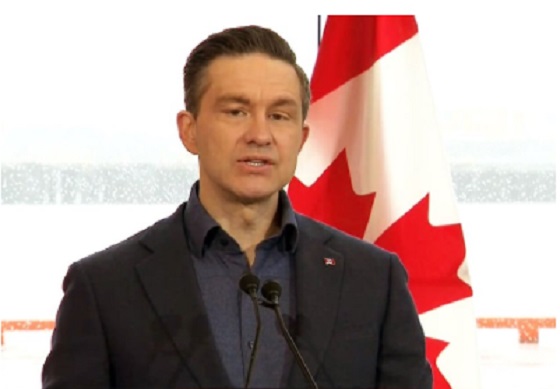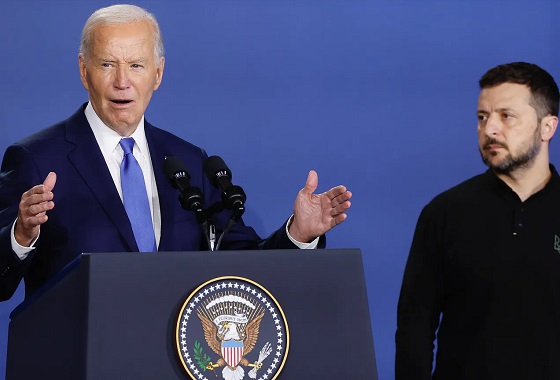Economy
Feds outline $83B in clean economy tax credits in bid to compete with U.S. incentive
Prime Minister Justin Trudeau and Deputy Prime Minister and Minister of Finance Chrystia Freeland arrive to deliver the federal budget in the House of Commons on Parliament Hill in Ottawa, Tuesday, March 28, 2023. THE CANADIAN PRESS/Justin Tang
Serious money is heading for Canadian industries looking to reduce emissions after the federal government unveiled its answer to the U.S. Inflation Reduction Act.
The spending commitments announced in Tuesday’s federal budget include tax credits for investments in clean electricity, clean-tech manufacturing, and hydrogen that together are expected to cost some $55 billion through to the 2034-35 fiscal year.
Total tax incentives amount to almost $83 billion over that timeframe when the carbon capture and storage and clean-tech investments credits announced last year are factored in, both of which saw minor boosts this round.
The government says the funding is necessary to boost clean economy spending from some $15 billion a year to the $100 billion a year needed. The spending is also needed to not fall behind as other countries roll out subsidies, most notably with the US$369 billion contained in the landmark U.S. legislation passed last year.
“In what is the most significant economic transformation since the Industrial Revolution, our friends and partners around the world, chief among them the United States, are investing heavily to build clean economies,” said Deputy Prime Minister Chrystia Freeland as she introduced the budget.
Tax credits are the backbone of the effort because they are stable and efficient way to roll out government support, while leaving decision-making with the expertise of the private sector, said a senior government official in the budget lockup.
Clean electricity is the biggest focus of the credits, costing $6.3 billion over the first four years starting in 2024, and $25.7 billion through to the 2034-35 year. Notably, provincial utilities and Indigenous-owned corporations will be eligible for the credits.
The spending is meant to help spur both more generation, as well as a better-connected east-west grid to meet the expected doubling of electricity demand by 2050.
The clean electricity package is where the government has likely done enough to meet its goals, said Michael Bernstein, executive director of Clean Prosperity.
Other funding areas however, including the $11.1 billion in credits for manufacturing and $12.4 billion for carbon capture through to 2034, likely aren’t enough to close the gap with what the U.S. is offering, he said.
“It really is one of those situations where your competitor has stepped up and said we are going to be providing an almost unthinkable amount of money.”
Canada has opted for construction-focused project support, while the U.S. IRA covers operational costs with payments based on production volumes. It’s like Canada is offering a single large cup of soda, whereas the U.S. is offering endless kiddy-cup sized refills, meaning Canada needs to offer a pretty big cup to compete, said Bernstein.
Since it’s not covering operations, Canada needs to move quickly on offering the carbon pricing backstop that it’s promised to develop in the budget, he said.
The so-called contracts for difference would provide certainty to industry on future carbon pricing and credits, but so far they’re still in consultation, as are several other key policies.
“What surprised me was how many things are still left to be determined,” said Rachel Samson, vice-president of research at the Institute for Research on Public Policy.
Along with the contacts for difference, she noted that details are scarce about how the $15 billion Canada Growth Fund will be spent.
The government announced in the budget that the fund will be administered independently by the Public Sector Pension Investment Board, with money starting to flow in the first half of the year, but didn’t provide guidance on priority areas.
Samson said it was good the government isn’t trying to direct the money itself, but worried that pension fund managers are too cautious to put the money in the bold projects needed.
“We need projects that are more on the cutting-edge, that are riskier.”
The government also pushed down the road any commitments on biofuels such as sustainable jet fuels, which surprised Samson as Canada is currently exporting the raw wood pellet feedstock and knows companies have projects ready to go.
The budget was also notable for what wasn’t in it for the oil and gas industry. While it did tweak last year’s carbon capture incentives, it didn’t go as far as some were pushing for, while the emissions cut-off for hydrogen production will likely exclude most carbon-capture based hydrogen projects.
“Oil and gas did not get a lot of what I think it wanted in this,” said Samson.
The lack of funding comes as climate advocacy groups have pushed against support for both programs as wasteful projects that don’t achieve the emission cuts needed in the near term, while also pushing against support for an industry that has reported record profits.
The government has also framed the budget as one of fiscal restraint that it hopes will allow private capital to do much of the heavy lifting to keep Canada in the running.
“Canada must either meet this historic moment, this remarkable opportunity before us, or we will be left behind as the world’s democracies build the clean economy of the 21st century,” said Freeland.
This report by The Canadian Press was first published March 28, 2023.
2025 Federal Election
Poilievre Will Bring in ‘One and Done’ Resource Approvals, and Ten Specific Projects Including LNG Canada Phase II

From Energy Now
Conservative Leader Pierre Poilievre announced that he will create a new ‘One and Done’ rule for resource projects: a one-stop shop, with one simple application and one environmental review. Poilievre also announced that he will rapidly approve 10 projects that have been stuck for years in the slow federal approval process. That will include Phase II of LNG Canada, a massive natural gas liquefaction project in Northern British Columbia. Many other projects will also be encouraged, all with an aim to bolster Canada’s economic independence against the Americans.
ONE-AND-DONE RULE will:
- Create a ‘One Stop Shop’ – A single office called the Rapid Resource Project Office will handle all regulatory approvals across all levels of government, so businesses don’t waste years navigating bureaucratic chaos and coordinating between multiple departments with different processes. We will cooperate with provincial governments to get all approvals into this single office.
- One application. End duplication – There will be one application and one environmental review per project, ensuring efficiency without sacrificing environmental standards. Instead of multiple overlapping studies that stall projects, governments will work together to deliver a single, effective review.
- One-year maximum wait times for approvals with a target of six months. There will be a target goal of decisions on applications in six months, with an upper time limit of one year, giving businesses certainty, cutting delays, and getting shovels in the ground faster.
“After the Lost Liberal decade, Canada is poorer, weaker, and more dependent on the United States than ever before, especially as a market for our natural resources,” said Poilievre. “My ‘One-and-Done’ rule will quickly and safely unleash Canada’s natural resources by rapidly approving the projects Canadians need more of now: mines, roads, LNG terminals, hydro projects, and nuclear power stations, so we can stand on our own two feet and stand up to the Americans.”
When completed, LNG Canada Phase II will double LNG output from 14 million to 28 million tonnes annually, creating hundreds of jobs in construction, operations and maintenance, and generating new revenues to fund the social programs that Canadians depend on. A new Conservative Government will also repeal C-69, the No Pipelines–No Development Law, and lift the cap on Canadian energy that would prevent LNG Canada Phase II from ever proceeding. Mark Carney has confirmed he will keep both C-69 and the cap in place.
Conservatives will also establish the Canadian Indigenous Opportunities Corporation (CIOC), to offer loan guarantees for local Indigenous-led resource projects.
A new Conservative government will also rapidly review nine other projects to find the hold-ups and accelerate federal decisions to get industry moving, workers working, and dollars flowing back to Canada. The full list of projects is at the end of this release.
Mark Carney and Steven Guilbeault’s “keep-it-in-the-ground” ideology–which maintains Bill C-69, the energy production cap, and the industrial carbon tax–will continue to stifle development in Canada, leading to job losses and increased reliance on foreign imports. Carney has said that “more than 80 per cent of current fossil fuel reserves … would need to stay in the ground.”
“The choice is clear: a fourth Liberal term that will keep our resources in the ground and keep us weak and vulnerable to Trump’s threats, or a strong new Conservative government that will approve projects, unleash our economy, bring jobs and dollars home, and put Canada First—For a Change.”
Some of the priority projects a Poilievre government will work with proponents and First Nations to approve:
- LNG Canada Phase II Expansion Project (BC): Aims to double LNG output but faces power supply challenges and output limitations related to the emissions cap.
- Suncor Base Mine Extension (Alberta): Expansion of an existing mine anticipated to produce 225,000 barrels per day of bitumen froth. Under assessment with the IAAC since 2020.
- Rook 1 Uranium Mine (Saskatchewan): A development-stage uranium project expected to be a major source of low-cost uranium. Approval process started in 2019 with the Canadian Nuclear Safety Commission.
- Springpole Lake Gold (Ontario): A proposed gold and silver mine with an on-site metal mill. Under assessment with the IAAC since 2018.
- Upper Beaver Gold Mine (Ontario): A proposed underground and gold and copper mine. Under assessment with the IAAC since 2021.
- Northern Road Link (Ontario): A proposed all-season, multi-use road in northern Ontario. Under assessment with the IAAC since 2023.
- Crawford Nickel Project (Ontario): A proposed nickel-cobalt mine with an on-site metal mill. Under assessment with the IAAC since 2022.
- Troilus Gold and Copper Mine (Quebec): A proposed gold and copper mine. Under assessment with the IAAC since 2022.
- Sorel-Tracy Port Terminal (Quebec): A proposed new port terminal in the industrial-port area of Sorel-Tracy. Under assessment with the IAAC since 2022.
- Cape Ray Gold and Silver Mine (Newfoundland): A proposed gold and silver mine with a milling complex. Under assessment with the IAAC since 2017.
Business
Trump eyes end of capital gains tax in 2025

 MxM News
MxM News
Quick Hit:
In a historic announcement that rattled markets and reignited debate over tax policy, President Donald Trump revealed plans to eliminate the capital gains tax starting in 2025. The unprecedented move would allow Americans to retain all profits from asset sales—whether in stocks, real estate, or other investments. Supporters tout it as a bold pro-growth measure, while critics warn it may cause budget strain and market instability.
Key Details:
-
President Trump announced the elimination of capital gains tax effective 2025, describing it as a move to reward success and promote wealth-building.
-
Currently, capital gains are taxed at rates up to 20%, with additional surcharges for high earners.
-
The announcement caused a major rally across financial markets, though critics claim the change favors the wealthy and could disrupt the economy.
Diving Deeper:
At a press conference on Monday, President Trump laid out a sweeping proposal to eliminate the capital gains tax in its entirety, calling it a “long-overdue correction” to what he described as a punitive tax on prosperity. “Why should you be punished for building wealth?” he asked. “This is America—we reward success.” If enacted, the change would allow investors to retain 100% of profits from the sale of assets such as stocks, homes, and businesses, with zero tax liability.
This proposal marks a sharp departure from decades of entrenched U.S. tax policy. Currently, long-term capital gains are taxed at rates ranging from 0% to 20%, with potential surcharges including the 3.8% Net Investment Income Tax for high earners. Trump’s plan would zero out those liabilities entirely starting in the 2025 tax year.
Conservative economists and market analysts have lauded the move as potentially the most transformative supply-side reform since the Reagan era. They argue that removing the tax will unshackle trillions of dollars currently locked in unrealized gains, spurring investment, entrepreneurship, and broader economic dynamism. “This is a game-changer,” said one pro-growth advocate. “It sends a clear message that America is back to being the most investment-friendly nation on Earth.”
Predictably, left-wing critics erupted. One Democratic senator labeled the measure a “grenade” that would detonate the federal budget and widen the wealth gap. Others warned of asset bubbles and increased volatility as investors rush to dump assets ahead of the reform’s implementation. These concerns, however, do not seem to have spooked the markets—at least not yet.
The Dow Jones Industrial Average jumped nearly 600 points following the announcement, while cryptocurrencies surged on expectations of tax-free gains. Real estate portals and trading platforms like Robinhood and E*TRADE saw surges in activity as users began strategizing around the policy’s timing. Online, the announcement triggered a wave of memes and commentary. The hashtag #NoCapGains began trending on X (formerly Twitter), with some calling it a “wealth liberation act” and others denouncing it as “Robin Hood in reverse.”
Legislation to formalize the proposal is expected to hit Congress within weeks. While Republicans have largely expressed support, Democrats are preparing for a fierce battle. It’s unclear whether some establishment Republicans—many of whom have been resistant to bold reform under Trump—will help move the bill forward or slow-walk it in favor of more moderate compromises.
Until the law is officially passed, financial advisors are urging caution. “The promise of zero capital gains tax is tempting,” one planner said, “but don’t bet the farm until it’s signed, sealed, and delivered.”
Still, with the 2025 tax season approaching fast, the stakes are enormous. If passed, Trump’s plan would not only mark one of the most dramatic tax overhauls in modern history—it would redefine the very incentives that drive American investment and wealth accumulation.
-

 Courageous Discourse1 day ago
Courageous Discourse1 day agoEurope Had 127,350 Cases of Measles in 2024
-

 2025 Federal Election2 days ago
2025 Federal Election2 days agoPierre Poilievre Declares War on Red Tape and Liberal Decay in Osoyoos
-

 Podcasts1 day ago
Podcasts1 day agoTrump’s Tariffs: The US, Canada, and the rest of the world
-

 2025 Federal Election24 hours ago
2025 Federal Election24 hours agoMark Carney Comes to B.C. and Delivers a Masterclass in Liberal Arrogance
-

 Alberta2 days ago
Alberta2 days agoIs Canada’s Federation Fair?
-

 Business23 hours ago
Business23 hours agoTrump threatens additional 50% tariffs on China, urges ‘patience’
-

 COVID-192 days ago
COVID-192 days ago5 Stories the Media Buried This Week
-

 International2 days ago
International2 days agoBiden Lied About Everything, Including Nuclear Risk, During Ukraine Operation






